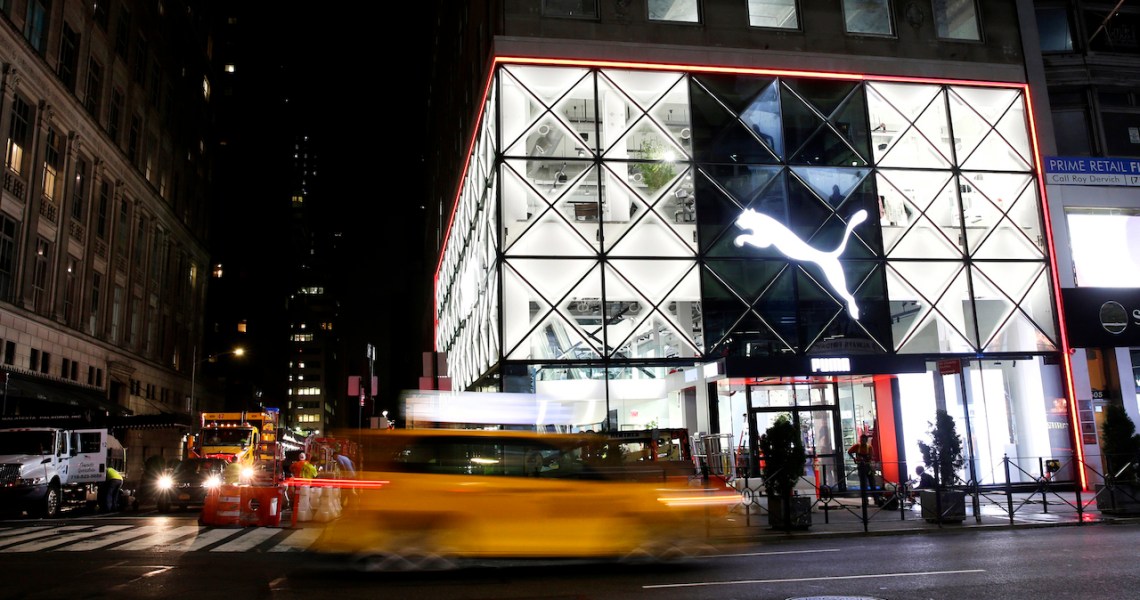From Versace to Henri Bendel, retailers are fleeing 5th Avenue as they continue to struggle and costs of these once coveted spaces continue to shoot up. But in the wake of some major departures, a new crop of brands is settling in. The strip once famous for luxury retailers is now making way for activewear brands, from Nike to Puma.
Brands including Asics, Lululemon and Adidas all have sizable retail spaces along 5th Avenue. Adidas opened in late 2016, followed by Asics in late 2017. Lululemon recently opted out of a short-term lease signed in 2017 for a 5th Avenue space, in favor of a larger, 20,000-square-foot space nearby. Then there’s Nike, which opened a six-floor, 68,000-square-foot flagship called the “House of Innovation 000” late last year. The latest to join the mix is Puma. Earlier this week, the brand opened an 18,000-square-foot store after spending several years searching for a space that made sense.
“It took a long time to figure out where we could find the right location. We really tried to think about what’s going to be different from our competitors but also allow people to come and share things,” said Allison Giorgio, vp of brand and marketing at Puma Group.
Not only are activewear brands flocking to 5th Avenue, but they’re also bringing a new approach to the large stores. Mainly, they’re paying closer attention to how to infuse technology into the shopping experience. While former tenants focused on bright window displays meant to draw in shoppers, the Pumas of the world are looking to engage shoppers through tech.
“With larger spaces comes more opportunities to engage customers not only to shop but also feel to like they are living the brand lifestyle. More space allows brands to curate in different ways based on new product releases,” said Avery Faigen, retail analyst at retail technology company Edited.
Take Nike’s “House of Innovation 000” space, which is packed with technology designed to improve the shopper’s experience. With a “shop the look” feature, customers can use the NikePlus app to scan a code on any in-store mannequins to see all the items on that mannequin. From there, the customer can request any of those items to be sent to a fitting room, and check for other colors and sizes in stock. Shoppers can also utilize instant checkout at one of the many stations throughout the store. Using the Nike app, customers scan their items and pay using their phones.
“Given that 60% of shoppers use their own phones while in-store anyway, having technology integrated into the store experience is a good way to keep the dialogue between your brand and the customer, as long as the technology enhances the experience,” said Leigh Sevin, co-founder of retail app Endear.
Puma has also doubled down on technology and experiential activations to get customers in the door. While Nike offers a lot of tools to make the shopping experience simple and fast, pieces inside Puma are aimed at keeping customers engaged longer.
“It’s no secret that brands are struggling to upkeep and maintain storefronts. So it’s important they’re able to offer some experiential elements that can’t be achieved through e-commerce. These creative concepts turn the store into more than a shopping destination, but a tourist attraction,” said Faigen.
Inside the new flagship, Puma has three experiential activations tied to some of its big sponsorship sports, including a professional-grade Formula 1 racing simulation where customers can virtually race the streets of NYC or play a game of NBA2K in the basketball zone. For soccer fans, there is an in-store simulator where shoppers can brush up on their foot work.
Outside of experiential activations, the brand has taken a note from Nike and infused technology into the store in other ways. Puma worked with IOT platform Evrythng and intelligent label solution company Avery Dennison Corporation to equip every product in the store with a unique QR code. Customers can scan the code with their smartphone to learn more about the product or buy directly from the e-commerce site if the style or color they want is out of stock.
Product labels in the store all have integrated RFID technology, allowing the brand to accurately asses its store inventory, quickly, and help the brand identify when any items that are returned to the store might be counterfeit.
For now, the activewear space is riding high, and it seems that more activewear brands will keep finding vacancies on 5th Ave. But Faigen said, just because there’s demand now, there’s no telling how long that buzz will last.
“Athletic brands are extremely trendy right now, and with a presence on 5th Avenue, they will no doubt do well. However, only time will tell when the demand for these labels drops off and the next big trend comes along. This’ll push these brands out like they are doing now to Gap and Henri Bendel,” she said.




